Super heavy trophy
Unlucky defender of the German General Staff
Works on super heavy tanks and self-propelled rigs based on them in Germany were officially rolled up in the second half of July, 1944. In practice, the order of the 6 Division of the Armaments Department on the delivery of a reserve of shells and towers for scrap, handed over to 27 in July, was not even executed. Concern Krupp hid the available backlog in warehouses, where they were later discovered by the British and Americans.
19 August, Krupp management informed Porsche that the Arms Service had instructed to stop work on the Typ 205 project. Specialists who assemble the second prototype left Boeblingen. However, this did not mean that the tests Pz.Kpfw. Maus is over.
In the fall, the second prototype of the tank, bore the designation Typ 205 / II, received a new engine. Instead of a gasoline Daimler-Benz MB.509, the car received a diesel MB.517. For the first time this motor was supposed to be put on a tank in the fall of the 1942 of the year. At the same time, the engine was already available in a turbocharged version, thanks to which its power increased to 1200 horsepower. It is not known exactly when MB.517 was installed in a tank, but in a correspondence dated 1 on December 1944 of the year, it is stated that the engine is installed in the Typ 205 / II, and its tests have not yet been carried out.
By the way, Porsche managed to install the engine to bypass the SS, which oversaw its development. When the SS men came to their senses, it turned out that one of the two engines, each of which cost the Germans in the 125 000 Reichsmarks, is already in the super heavy tank.
The latest "lifetime" photograph of prototypes Pz.Kpfw.Maus. It was made at the warehouse of the railway station Ruchleben in January 1945
The only effective way to stop work on fine-tuning a super-heavy tank was to seize the “favorite toy” from Porsche. At the end of December 1944, both samples are Pz.Kpfw. Maus was transported from Böblingen to a warehouse near the railway station Ruchleben on the western outskirts of Berlin. There they stayed at least until the end of January 1945, after which they were sent to the Kummersdorf test site, located in 25 kilometers south of Berlin. Here a technical description of the second prototype was made (at the same time the only one that had the turret and the armament), after which the tanks were placed in the hangar, which Porsche could no longer reach.
What happened to these machines from January through March of the year 1945 is unknown. There is no reliable evidence that they participated in any trials. However, it was precisely at this time that tests of the first prototype, designated the Typ 205 / I, could be carried out.
So Typ 205 / II discovered by Soviet troops
In March, the 1945 of the year Typ 205 / II was driven under its own power to Wünsdorf, 2,5 kilometers south of Zossen, where the headquarters of the German General Staff was located. In Soviet documents, by the way, this place was often designated as Stamlager. The car was included in the structure of the forces that were guarding the headquarters, in the area of Zossen also passed the outer ring of the defense of Berlin.
Much has been written about how Typ 205 / II was used in the battle for Berlin; quite a few copies have been broken in disputes on this subject. With a certain degree of confidence, we can only talk about with whom the super heavy Porsche tank could potentially fight. From the southeast, the 3 units of the Guards Tank Army attacked Berlin. 21 April 1945 of the 6 Guards Tank Corps, which was part of this alliance, reached the Topkhin, Tselensdorf line. There was quite a bit of time left for Zossen, he was captured during the night attack from 21 on April 22. Thanks to the confusion, the headquarters of the German General Staff was able to leave Zossen at the time of his employment with the 6 Guards Tank Corps. According to the memoirs of the commander of the 53-th Guards Tank Brigade, V. S. Arkhipov, before leaving, the SS men shot some of the staff officers, the rest were evacuated.
He's from the stern, in the background - the destroyed building of the cinema
As for Pz.Kpfw. Maus, his fighting career turned out to be short and sad. During the maneuvering engine crash occurred. The immobilized car was at the intersection of Zeppelinstrasse and Tsersensdorferstraße in Wünsdorf, not far from headquarters. She stood up so that it could not be used even as a fixed firing point. As a result, her crew simply had no choice but to undermine the tank. In short, no heroic defense happened, the super-heavy tank turned out to be a colossus with clay feet.
On the left side of the damage were minimal. In the background you can see the guard house, now in its place is a travel agency
In the memoirs of Arkhipov Pz.Kpfw. Maus V2 is mentioned, but with a clear distortion of the picture:
“In the town we captured three huge tanks. The hatches were open, everything was in order inside, even the ammunition was prepared for battle - they were removed from the factory grease. The tanks were so big that even the “Royal Tiger” would have looked like a wedge next to them. The tower is flat like a pancake. Armed with a tank 155-mm cannon. It looks like a very impressive car, but, having drawn an analogy with the “Royal Tiger”, I am sure that its driving characteristics were low. ”
The explosion blew off and an additional fuel tank. In the background you can see the bathhouse
Whether the literary editor has mixed Pz.Kpfw.Tiger II and Pz.Kpfw.Maus captured on the Sandomierz bridgehead, or Arkhipov has already confused something, but the reality turned out to be different. The tank went to the Red Army already undermined. By the force of the explosion, the right side of the hull was torn off to him and the tower was torn down along with a sub-towed shoulder strap.
Underestimation of combat mass
In view of the general confusion during May, no one had anything to do with the super heavy tank that was blown up at the intersection of the super heavy tank. The fact that the Germans not only developed, but also built superheavy tanks, Soviet specialists learned after the end of hostilities. Only at the end of May did a more detailed study of the military-technical heritage of the Third Reich, scattered around the German capital, begin. 29 June 1945 to the leadership of the State Defense Committee (GKO), including Stalin and Beria, were sent a memorandum signed by Marshal of the Armored Forces Y. Fedorenko, Chief of the Main Automobile and Armored Directorate of the Red Army (GABTU KA):
“I report that 4 of June this year, the Soviet occupying forces in Germany found two super heavy German tanks.
One of them, with an armed turret and a diesel engine, is 40 km south of Berlin in the Stamlagere region; a second tank with an untreated turret and a carburetor engine - in 62 km south of Berlin in the Kummersdorf area.
A special feature of super heavy tanks is the use of electric transmission and twin guns - large-caliber (128 mm) and caliber 75 mm.
According to the testimony of German engineers who worked at the tank range, superheavy tanks were designed by the designer Porsche in the Stuttgart-Boblingen region and were manufactured by Nibelungenwerk (in Austria).
At the end of December 1944, both tanks were delivered to the tank test site, from which one (armed) sample in March of this year was delivered under its own power to Stamlager.
I present the tactical and technical characteristics of the super heavy tank.
The characteristic is indicative, since both tanks were undermined and have not been studied in detail by specialists.
More accurate information I will report to you after a thorough study of these tanks by specialists. ”
The second sample of the super heavy tank caused the greatest interest. Despite the fact that the internal explosion caused him very serious damage, they studied mainly him. The fact is that the first model did not have weapons, and instead of a tower a mass-dimensional model was installed on it.
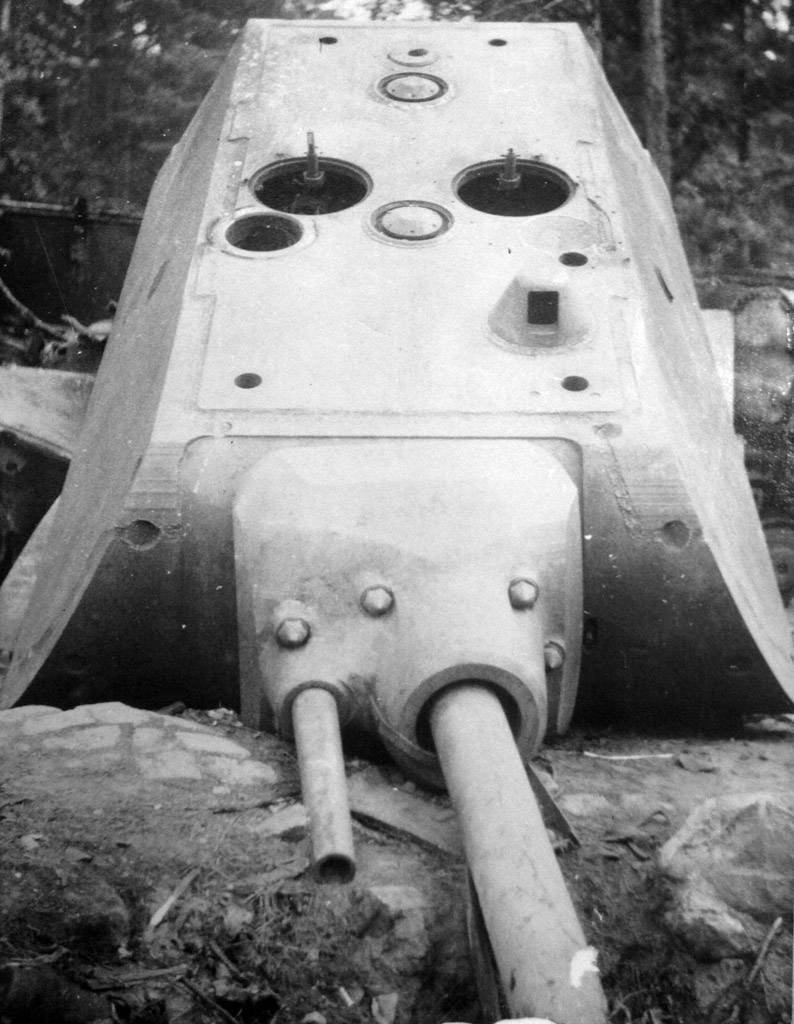
With the explosion of the tower hatches were torn out
To the place of detection arrived specialists, who began to study the wrecked tank. To begin, it was decided to make a brief technical description of the machine. The report turned out to be small - only on 18 pages. This was due to the fact that the order came from above to make a description of the detected machine as soon as possible. Such a rush did not look strange: in the hands of the Soviet military was a tank that looked like a much more dangerous enemy than all the combat vehicles with which they had previously met.
Destroyed the explosion and the guidance mechanisms of the gun
The contradictory testimony of German prisoners of war and severe injuries caused a number of inaccuracies in the written description. For example, the combat weight of the tank was estimated at 120 tons. The reason for this inaccuracy was not the mistake of the Soviet military. Exactly the same fighting mass was indicated at the end of 1944 of the year by German prisoners of war who were among the Allies. And this was not intentional misinformation. Prisoners of war told the truth, Pz.Kpfw. Maus really once weighed 120 tons. True, it was still at the “paper stage”: this was the initial design weight of the tank, dated by the beginning of June 1942. Since then, the machine embodied in metal has had time to "get better" more than one and a half times.
A shell reservation scheme prepared by Soviet specialists, basically corresponding to the real picture
Another serious inaccuracy crept into the description of weapons. In addition to the 128-mm long-barreled and 75-mm short-barreled guns, two machine guns of the strange caliber 7,65 mm were included in the description. Much more surprising is the fact that among the weapons was indicated and automatic gun caliber 20 mm. It appeared in the description, probably also from the words of prisoners of war. Strange as it may sound, such information is also not complete disinformation. Indeed, at the beginning of 1943, in projects Pz.Kpfw. Maus featured the MG 20 / 152 20-mm automatic cannon as anti-aircraft weaponry. True, this idea was prudently abandoned, since it was only vertically guided, and the use of a huge tank turret for pointing anti-aircraft guns horizontally was a ridiculous idea.
The layout of the super-heavy tank units
Despite such errors, in general, the technical description gave a very detailed picture of the internal structure of the tank and its body armor. Of course, there were some inaccuracies here too, but they turned out to be relatively small.
MB.517 diesel engine, the failure of which forced the Germans to blow up a tank
Special attention was given by Soviet experts to the power plant and transmissions of the super-heavy tank. Almost half of the technical description was devoted to these questions. Such attention does not look surprising: a year before in the USSR, there was an active work on the electric tank transmission, which ended in general unsuccessfully. Now, in the hands of the Soviet military was a tank with electric transmission, and even super heavy. Experts dismantled its engine on the spot and studied it. Also received with a guitar (gear transmission) and the drive wheel. The undercarriage of the tank was also studied in detail.
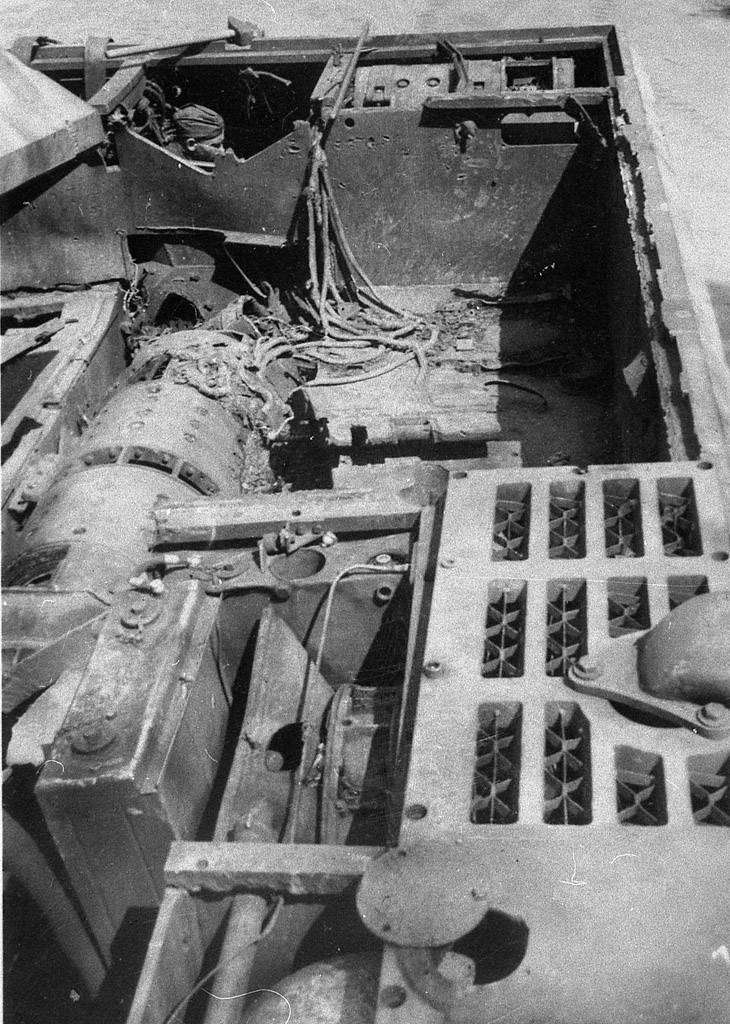
Study of the electric transmission of the tank
In the middle of summer 1945, the technical description went to Moscow. Meanwhile, the Kummersdorf training ground captured by the Red Army was gradually investigated by Soviet specialists. At the same time prisoners of the German military and engineers were interrogated. The amount of information on super heavy tanks began to grow sharply. The captured documents of the German Ministry of Weapons fell into the hands of the Soviet military, thanks to which, by the end of the summer of 1945, exact data on Pz.Kpfw were obtained. Maus. In addition, part of the factory drawings was found.
It is clearly seen that the perforated track rollers were again replaced by solid ones.
As already mentioned, both prototypes of the Pz.Kpfw fell into the hands of the Red Army. Maus. The first car was built on the shooting range of the Kummersdorf test site. Although, according to the information originally received, Typ 205 / I was also undermined, the available photographs refute this information. If they tried to blow up the car, it was clearly unsuccessful: I did not receive damage comparable to the damage of the second tank received from the detonation of ammunition. More like the fact that the car is already partially dismantled at the shooting range.
In this form, the first prototype of the tank was found on the shooting range. Visible traces of shells falling into the side of the hull and the layout of the tower
Interestingly, by the time this tank was discovered, there were four marks on its left side of the hull from hitting large-caliber armor-piercing shells. Another mark was on the left side of the mass-dimensional model of the tower.
Preparation for dismantling the tower layout
The fact that these markings may be the result of the shelling of a tank with Soviet guns is excluded. Numbers of nine similar in character were on the front hull sheet. The tank also stood parallel to the forest, and it was impossible to fire at a frontal projection from another point. By the time the machine was found at the shooting range, it was in a non-working condition, and it was physically impossible to deploy it for firing. In a word, the Germans themselves fired at the car, it is even possible that the Typ 205 / I fire led the second prototype. By the time the tank was detected, on the undercarriage protection against frontal fire, there were weldings for spare tracks, and in the area of these nodes there were three hits.
In order to pull off the tower, it took to hook for her a pair of cables
During the summer and early autumn of 1945, both cars gradually began to be dismantled. This was due to the fact that it was impossible to bring any of them into working condition. In addition, the units of tanks were of interest separately. To simplify the procedure for dismantling the mass-dimensional model of the tower with the first prototype tank thrown off. Removed components and assemblies were immediately described. In the autumn of 1945, the units removed from the tanks went to Leningrad to the branch of Experimental Plant No. XXUMX. Just at that time there was work on the design of a new heavy tank, and one of its versions involved the use of electric transmission.
Through the opening of the hatch is visible tank dashboard
A completely different fate awaited the tanks themselves. At the end of the summer of 1945, it was decided to assemble a “hybrid” using the Typ 205 / II tower and the Typ 205 / I chassis. This task turned out to be non-trivial, since it was not easy to evacuate just the 50-ton tower, which was resting on a torn under sheet. The problem was solved with the help of a whole chain of German half-tracked tractor units (mainly Sd.Kfz.9). Not without difficulty, this cavalcade dragged the tower to Kummersdorf, where it was possible to detach the padded shoulder strap. Already in September, a copy of Pz.Kpfw.Maus assembled from parts of both tanks was loaded onto a special platform that survived the war.
Interestingly, the hull numbers and turrets of different tanks are the same: a hull with the same 35141 serial number is installed on the hull with the 35141 serial number.
Pz.Kpfw.Maus, assembled from two tanks, Kummersdorf, autumn 1945 of the year
In this form, in Kummersdorf tank stood for quite some time. Despite the fact that he was ready to be sent back in the fall of 1945, the order to transport it to NIABT Polygon was given only six months later. According to the landfill list, the car arrived in Kubinka in May 1946. Here, the study of the tank continued, but in a simplified mode. Since its units went to Leningrad, there was no question of any running trials. Mainly in Kubinka, materials were prepared on the study of the elements of the undercarriage. Firing tests were also excluded, since the gun mount was damaged by an explosion, and the 128-mm cannon barrel was practically loose.
As you can see, on the front sheet of the hull there are marks from hitting projectiles
One of the few tests that were conducted on the NIABT Polygon was shelling. It was produced in abbreviated form. One shot was made on the frontal part of the hull and starboard, as well as in the front of the tower and its starboard. All other traces of hitting the tank are of “German” origin.
Tank from starboard
Unlike the super-heavy tank E-100, which the British sent for scrap metal, its competitor was more fortunate. After studying Pz.Kpfw. Maus towed to the museum at the site. At that time it was an open area. A full-fledged museum appeared here already at the beginning of the 70-ies, when the tank took its place in the hangar of the German armored vehicles.
Recently, the idea arose to restore the car to running condition, but the project did not go beyond the preparatory work. This idea is, of course, interesting, but as a result of its implementation, it is unlikely that you will get something other than a stuffed animal with dubious prospects from the point of view of reliability. After all, not only is all the units removed from the machine, one of the carts is also missing. The resource of the huge tank tracks is very low, and repairing a torn 180-ton vehicle track in the field is a dubious pleasure. And this is only a small part of the problems that will inevitably arise when trying to restore this tank to the running state. In the end, even just to transport it is a very difficult task.
Growth generator
We should also mention the influence of the captured German super-heavy tank on the development of Soviet tank building. In contrast to the British and Americans, who almost did not respond to the detected materials on the E-100 and Pz.Kpfw. Maus, the reaction of the Main Armored Directorate of the Red Army (GBTU KA) turned out to be lightning.
There is nothing surprising in this. 5 June 1945 was presented the draft design of a heavy tank "Object 257", which had increased armor protection and 122-mm gun BL-13. It was assumed that this machine will be a real leap forward for the Soviet tank building. And then, quite unexpectedly, it turned out that a tank was found in Germany, which was penetrated with difficulty by a promising cannon, and the gun mounted on it completely pierced the armor of the 257 Object.
German super heavy tank on NIABT polygon. Cuban, 1946 year
11 June 1945, a draft tactical and technical requirements for the new heavy tank was developed. His combat weight was approved within 60 tons, the crew increased to 5 people. The armor was supposed to protect the tank from the 128-mm German cannon. In addition, in addition to the BL-13 gun, there was a requirement for another weapon, caliber 130 mm. In addition to the launch of a program to create an "anti-mouse" tank, these tactical and technical ones are difficult to explain. It was from them that the tank was born, known as the EC-7.
Same front
The German tank discovered provoked a second wave of the arms race, similar to the one that generated the KV-3, KV-4 and KV-5. Instead of focusing on improving the existing good samples, the designers began work on the creation of steel monsters. Even the EC-4 now seemed outdated: according to the plans for the second five-year plan of the 40-s, from 1948, it was planned to produce heavy-duty tanks of the new type (EC-2760) per year. By the way, the “7 Object” was far from the heaviest and heavily armed. In Chelyabinsk, they worked on a heavy tank project called “The 260 Object”, the heaviest version of it was to have a 705 caliber gun, and the combat weight would be 152 tons. In addition to tanks, self-propelled units based on EC-100 and EC-4 with long-barreled guns of caliber 7 mm were also studied.
On the museum site, 50's. It is clearly visible that a trace appeared from the front hit sheet
Harmful all this vigorous activity caused no less than the development of steel monsters in the spring and summer of 1941 year. It came to making prototypes of the EC-7, although the government did not dare to launch a large series. Of course, the tank turned out outstanding, but too heavy. 18 February 1949, by decree of the USSR Council of Ministers No. 701 – 270ss, the development and production of heavy tanks weighing more than 50 tons was stopped. Instead, they began the development of a heavy tank, better known as the EC-5. Later it was adopted as the T-10.
The tragedy of the situation was that four years for Soviet tank building were largely wasted. The only worthy opponent for the EC-7 all this time was on the museum site in Kubinka. As for the former allies of World War II, they turned down the development of their armored monsters after the war. There was simply no one to fight the promising Soviet heavy tanks.
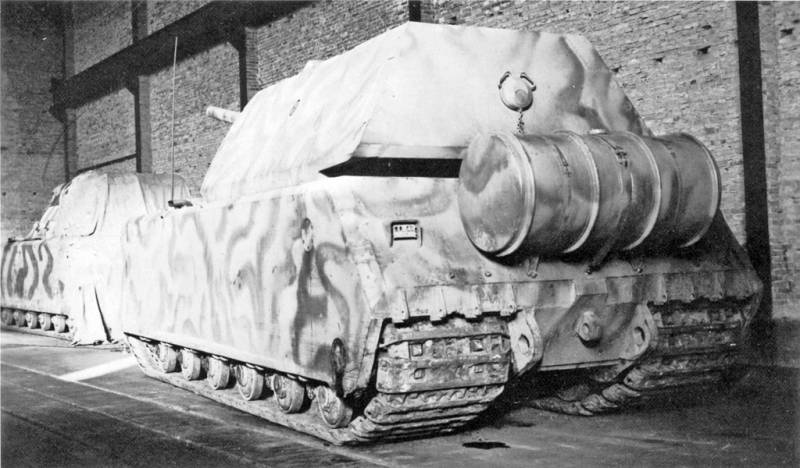
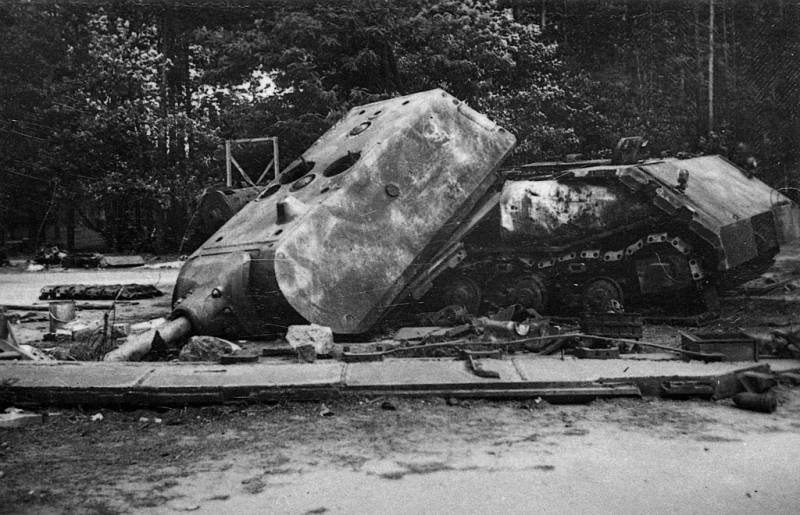
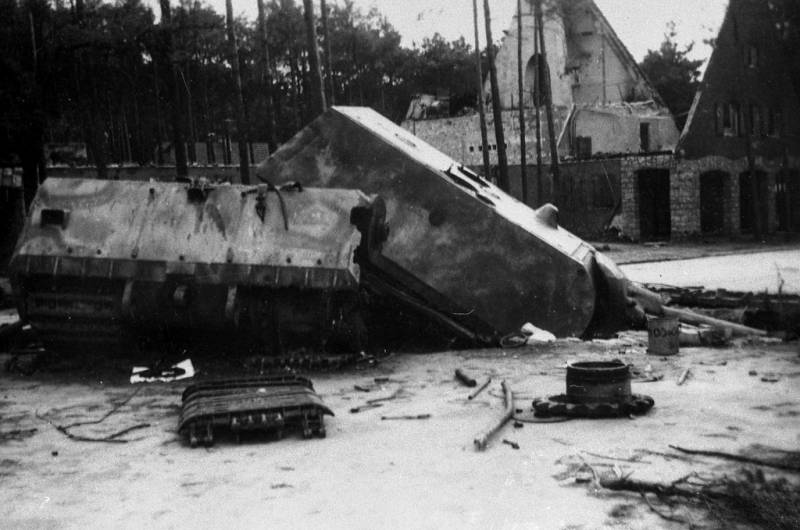
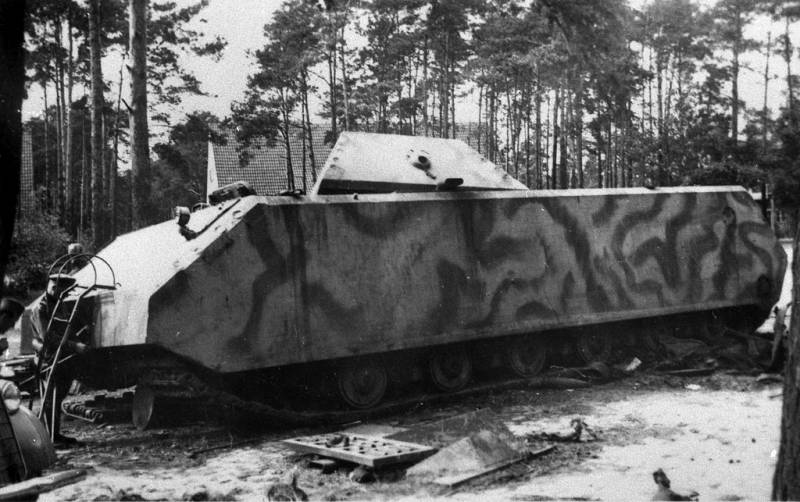
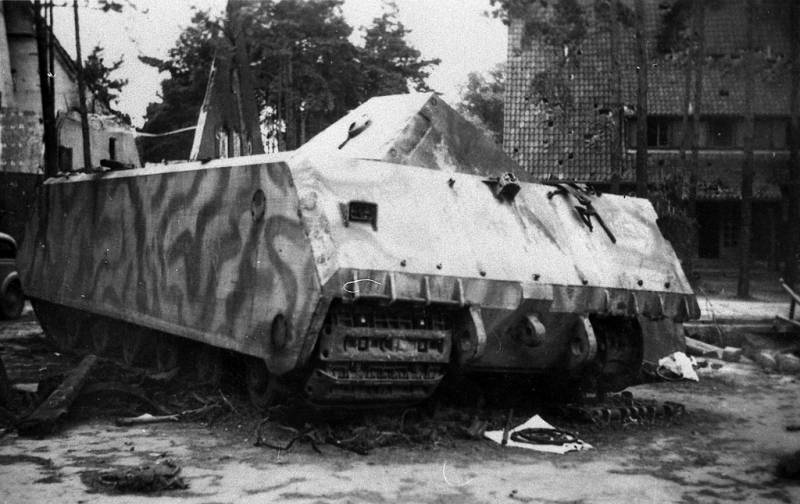
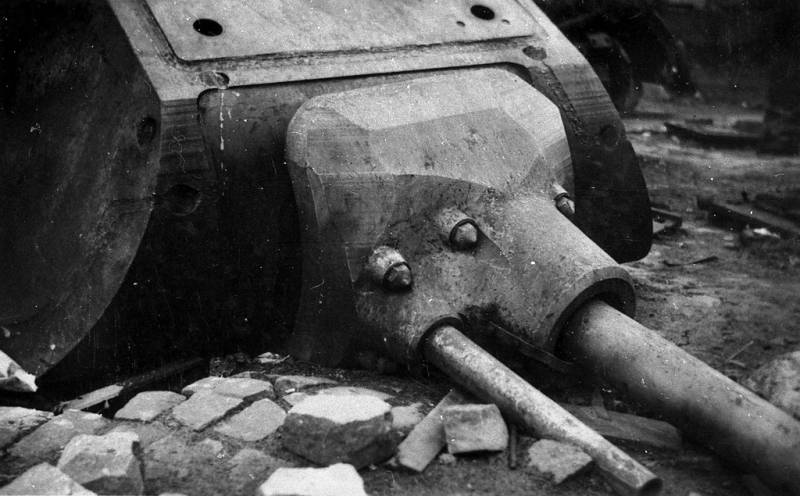
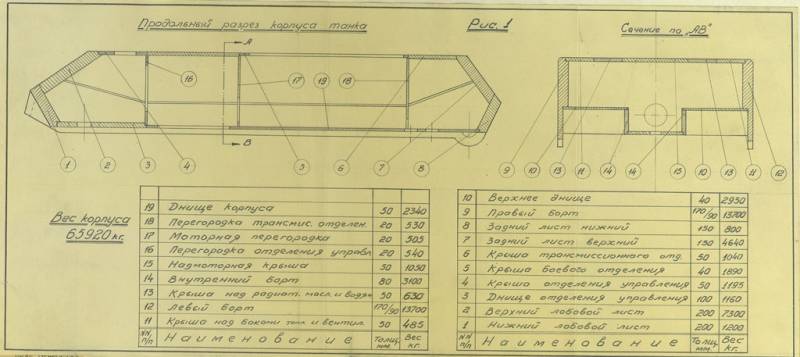
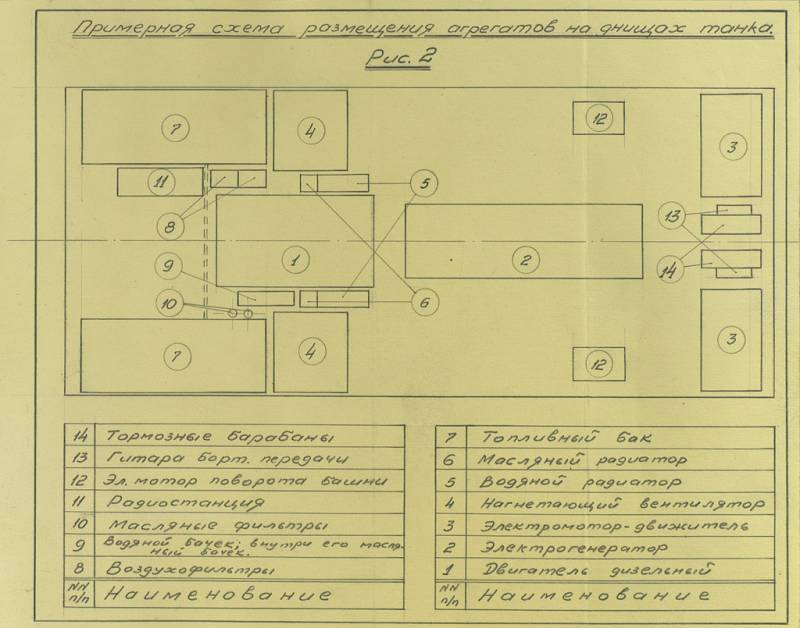
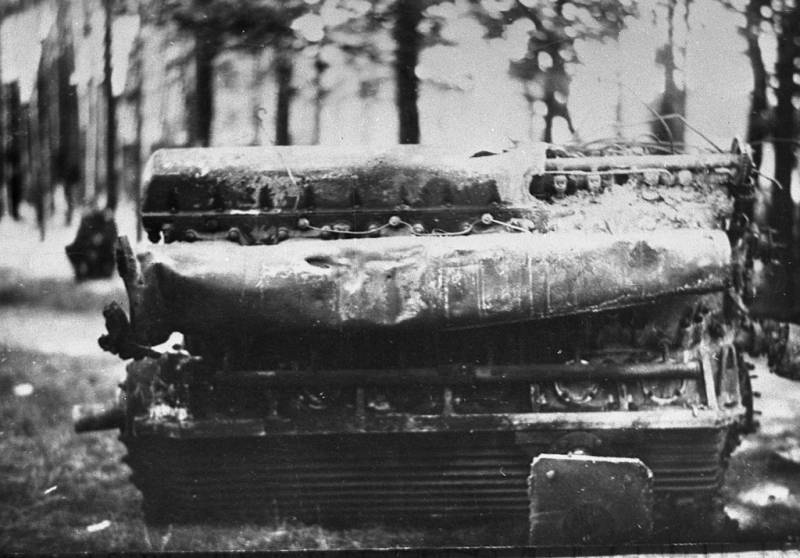
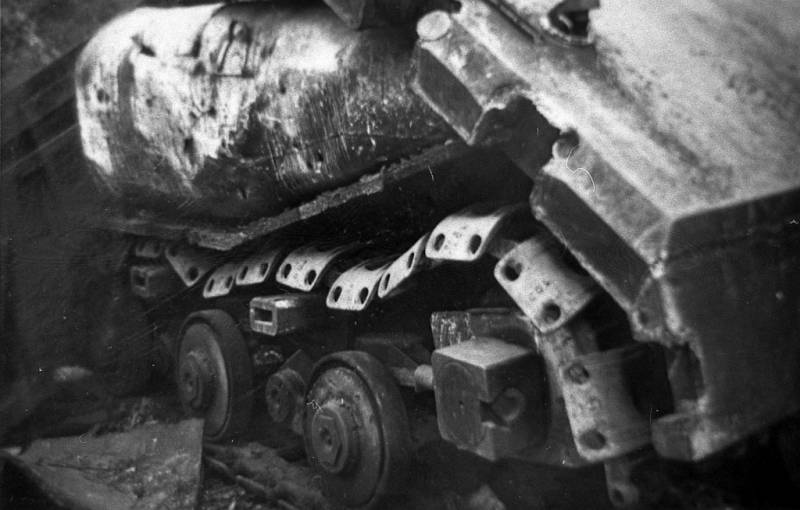
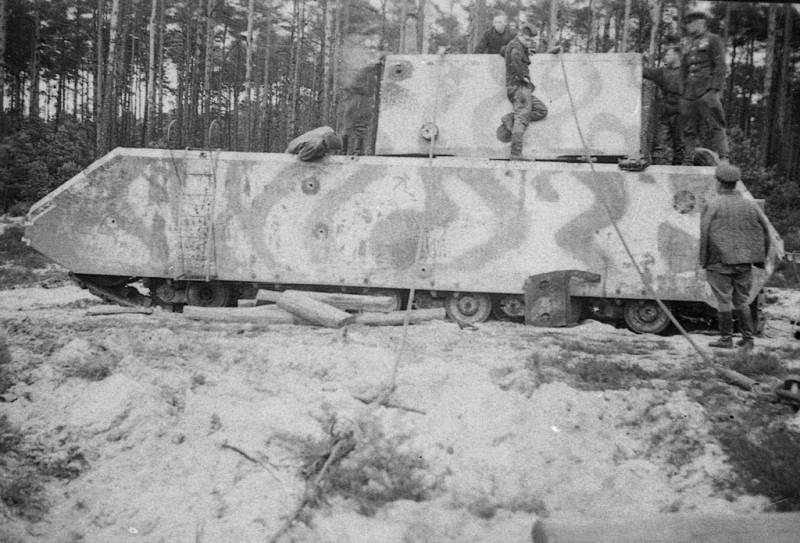
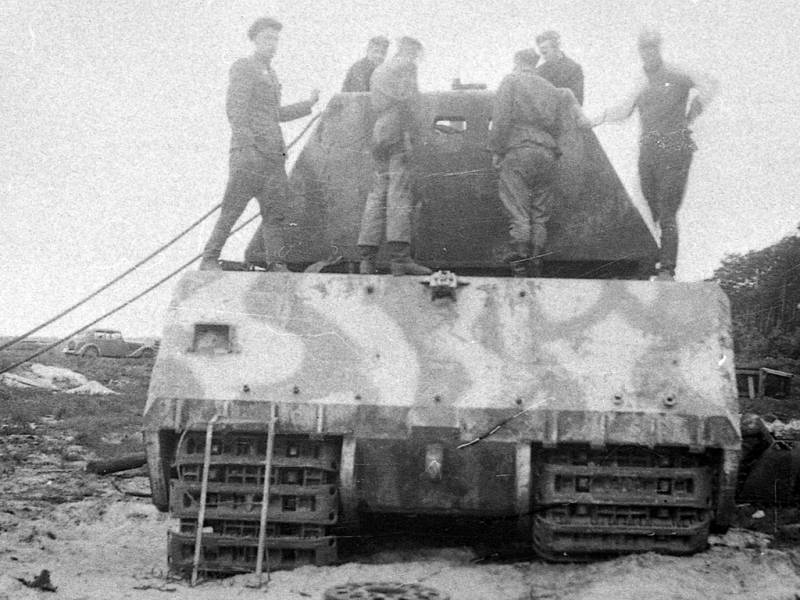
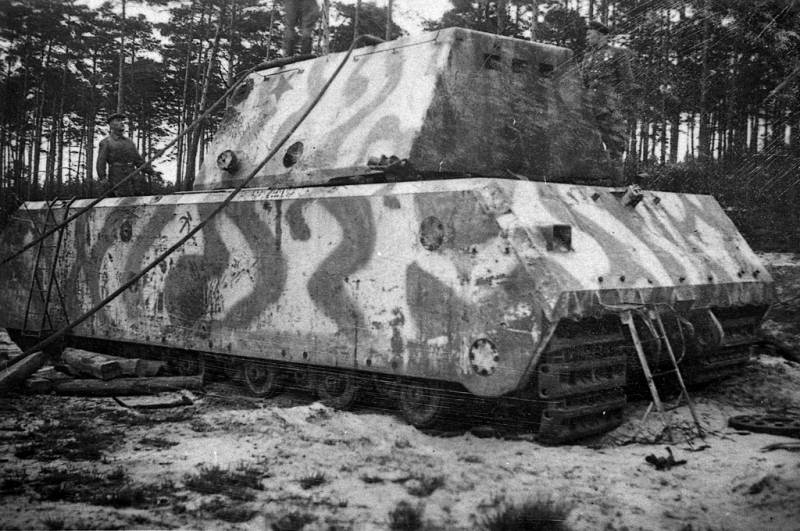
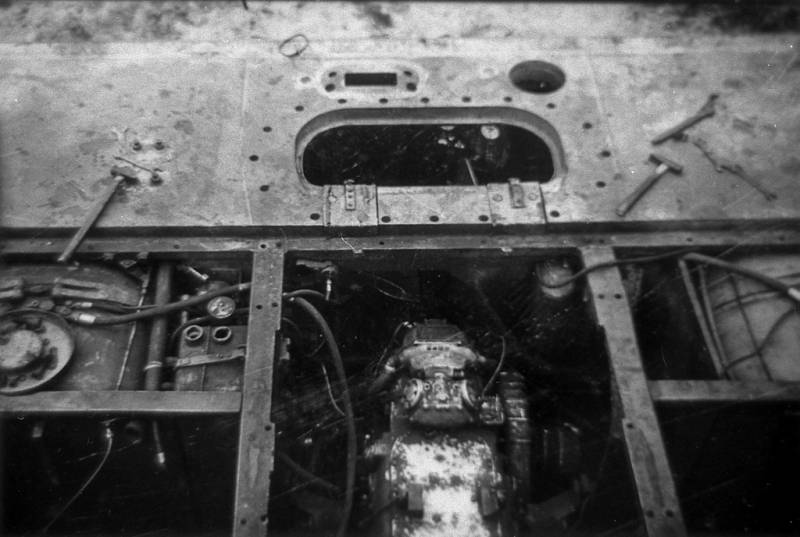
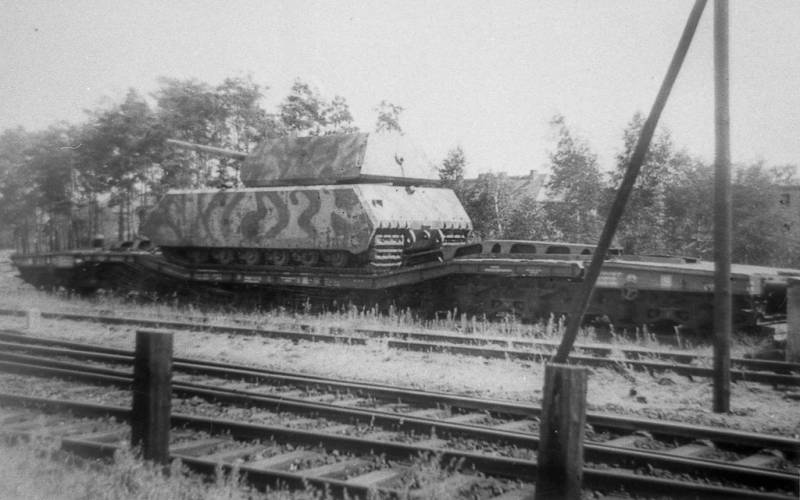
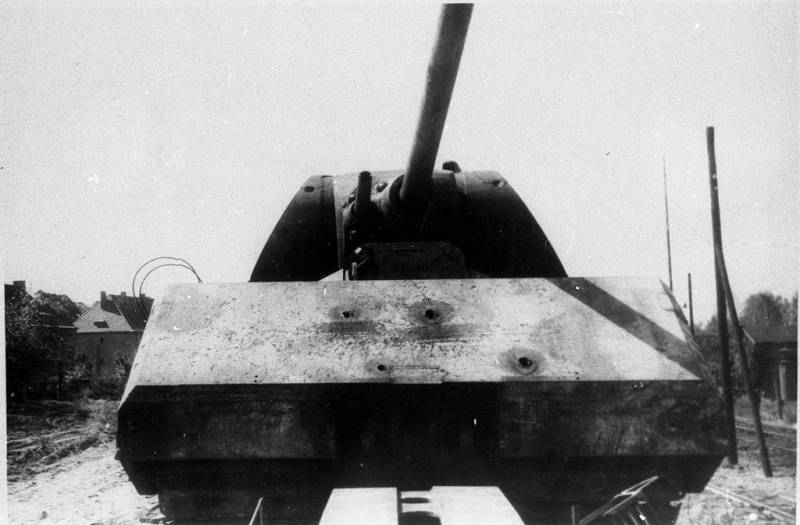
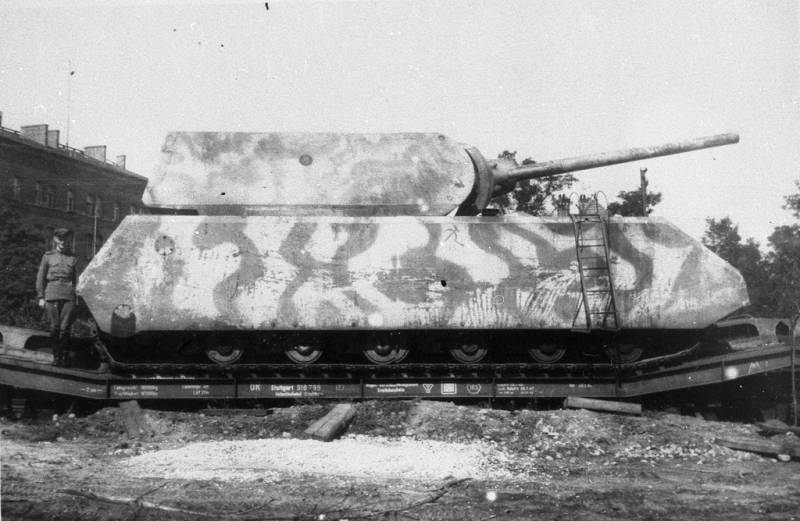
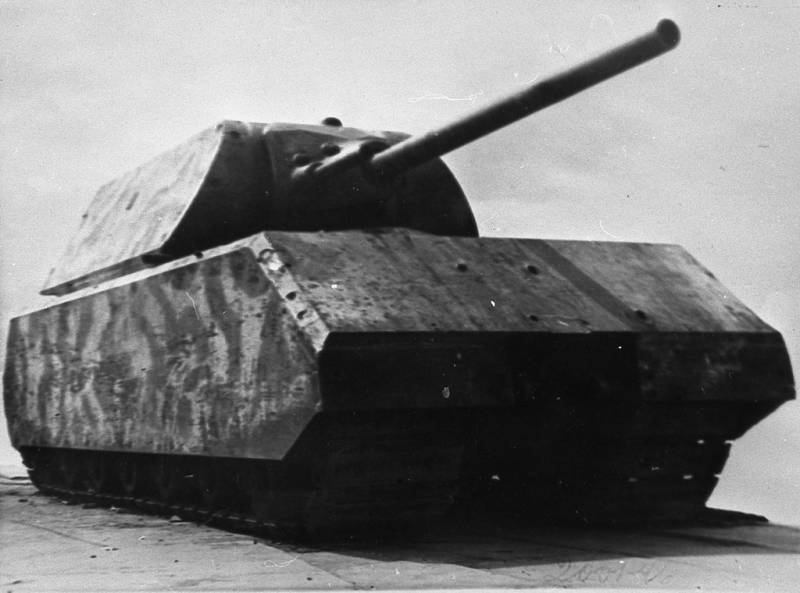
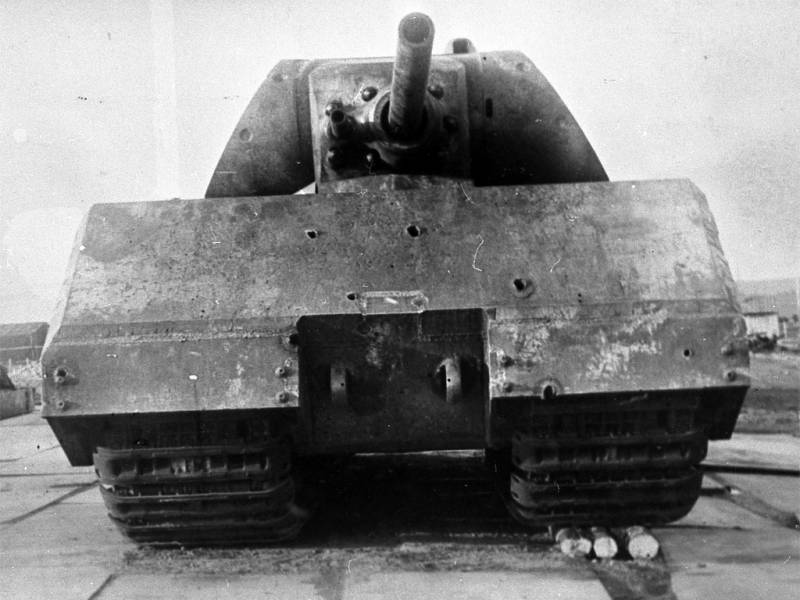
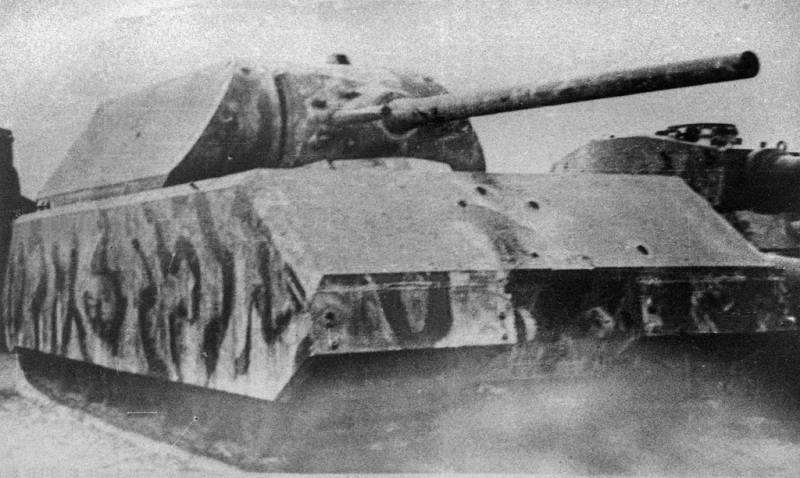
Information